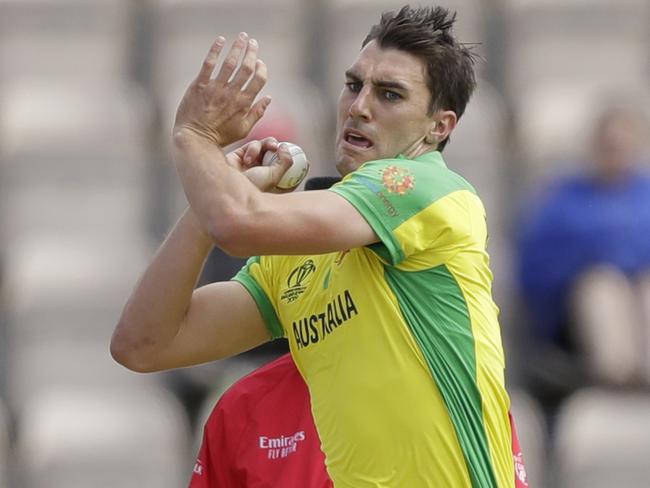Cricket World Cup: How to succeed at the art of death bowling
Death bowling has become a vital ingredient to success in one-day cricket. But having a plan and executing it are two very different things.
Cricket
Don't miss out on the headlines from Cricket. Followed categories will be added to My News.
- Every cricket World Cup ranked from worst to best
- Puff out your chests Australia - it’s time to win
- Alarming data which has Aussie quicks fearing the worst
World Cup ambitions triumph or perish in the death zone. It’s the harshest of climates for those who have climbed to the sport’s pinnacle. One mistake and you’re gone. Lose your grip and you plummet.
Conditions in England and the nature of the modern game - big bats, small grounds, little swing - mean it is bowlers who are most likely to suffer.
The bad news for Australia is that its best bowler in the final overs, Josh Hazlewood, is not in England. Overlooked by selectors because of his lack of cricket, the seamers: Pat Cummins, Mitchell Starc, Nathan Coulter-Nile, Jason Behrendorff, Kane Richardson and Marcus Stoinis are competing for the responsibility of taking the ball at the end of the innings.
The quicks are bowling at cones at training and coaching staff are keeping score, clearly convinced the yorker - wide or straight - is the way to go. Pat Cummins said the other day he is coming last in the competition, but explains he is more confident bowling at people than inanimate objects.

“I’m a bit better when there’s a batsman standing there but when there’s a cone I can’t get near it,” he said.
The most dramatic death bowling in Australian cricket history was Damien Fleming’s four balls to Lance Klusener in the 1999 World Cup sem-final.
The Australian swing bowler had been the go-to man for a long time previous and backed himself if a side needed more than eight runs in the over. He’d done the job against the West Indies in 1996 but this was Lord’s, the wicket was flat, the ball wasn’t swinging and it was the hardest hitter in the game facing up and the South Africans only needed nine to advance.
The plan devised the night before was to go around the wicket and bowl yorkers 30cm outside off stump. The first hit the fence so hard it bounced back to Fleming. The second got the same treatment. Fleming decided to back himself and come over the wicket. The South African batsman panicked and Australia got through.

Confidence and practice was the key. Fleming wanted the ball in these situations.
“I didn’t want to have the pain of having no control over the result and be sitting there in the field,” he told Cricinfo some years back. “If I failed, at least I could look in the mirror and say, “It was my fault”, or “They were too good for me.” I couldn’t imagine how nervous I would be watching the last over and hoping we would win.”
Lasith Malinga may be the Fleming of this era. His performance in the IPL final a few weeks back was incredible.
He’d gone for 42 in his previous three overs, he was belted from the attack by Shane Watson but brought back at the death. Chennai Super Kings, like South Africa, needed nine to win. He contained them for four balls, but they only needed two runs with two balls remaining. The bowler, who had been operating at around 140km/h, backed himself and sent down a dipping 112km/h yorker that trapped Shardul Thakur LBW.
The courage and skill of the bowler won the day.
When asked by News Corp Australia in the UK this week, Malinga explained this week that those two things, along with practice and game awareness, are the key to bowling in the death zone.

“A bowler needs to get a skill first and then analyse the game,” he said. “He needs to improve his skill and have the confidence to deliver. Analysis is important.
“In the final over I bowled five quick balls but when they needed one run to get to go to a Super Over and I realise I needed a wicket. My wicket taking option was the slower ball and I had the confidence to bowl it. I wanted to be a match winner.”
Malinga says he bowls a minimum of 12-18 deliveries at every training session practicing “death bowling” but the key is to do it at the end of the session because it simulates the game situation when the bowler is tired but must execute.
Variety, too is important. Fleming had a slow ball, a fast cutter and another slow ball that came out the back of his hand as well as his natural swing.

Statistics compiled by Cricbuzz indicate that since 2015 Australia sits mid table for scoring and bowling in the last 10 overs. While the side has improved remarkably in the latter part of that four year period, the disturbing thing about the analysis is that Josh Hazlewood is far and away the best bowler at the tail end of the game.
Rohit Sharma, Jos Buttler, Faf du Plessis and Glenn Maxwell are the five best batsmen in such situations. Matthew Wade was in the top 10 but is also not here.
India’s Jasprit Bumrah is the best bowler in the situation and his support act, Bhuvneshwar Kumar, an outstanding support. England, who lead the way with the bat, have a weakness with the ball in the final stanzas of the game.
Cummins says he is practicing his variations for “the death” and confident if he gets a chance to close out the innings.
“That’s the time when you’re really trying to deceive them,” he said. “Definitely some subtle variations, try and bowl some slower balls. Probably bowl them in the middle more than I did in the past and the bouncer… batters are so good, if you give them six balls in the same spot, they’re probably going to put them away. You’ve got to have some options.”
Originally published as Cricket World Cup: How to succeed at the art of death bowling



